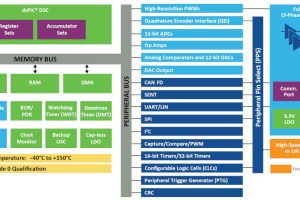
Called THVD1424, it includes switchable on-chip 120Ω termination resistor, slew rate control, and both half-duplex (two-wire) and duplex (four-wire) modes – allowing a single PCB type to be created that can be software re-configured for different applications.
“All the features are pin-controlled,” said TI. “This enables the device to be used at end nodes or middle nodes, two-wire or four-wire, slow or fast. Wide common-mode voltage range and low input leakage on bus pins makes the devices suitable for multi-point applications over long cable runs.”
The bus-side supply can range across 3 to 5.5V – with a 5V supply, the bus’s differential output exceeds 2.1V for Profibus compatibility.
The logic supply range is 1.65 to 5.5V, making the IC able to work with 1.8, 2.5, 3.3 or 5V logic.
Consumption is <3mA operating and <5µA shut down. Power-up and power-down are “glitch-free for hot plug-in capability”, claimed TI.
There are separate pins for half/full-duplex, A-B input 120Ω termination resistors, X-Y input 120Ω resistors, Rx enable, Tx enable and 500kbit/s or 20Mbit/s slew. All have in-built pull-up or pull-down resistors to establish stable default states.
In half duplex mode, output and input share the X-Y pin pair.
Internal bus-side receiver input biasing causes the receive logic output to go fail-safe ‘high’ if the transceiver inputs go open-circuit, if the bus lines are shorted, or the bus is idle (not actively driven).
The bus pins are heavily protected against potentially destructive transients, including: ±16kV HBM ESD, ±8kV IEC 61000-4-2 contact discharge, ±15kV IEC 61000-4-2 air gap discharge and ±4kV IEC 61000-4-4 fast transient burst. Abs max sustained voltage in any bus pin is ±16V with respect to the ground pin (not shown in the diagram).
The device is characterised for ambient temperatures from –40 to 125°C.
Packaging is 3 x 3mm thermal pad 16pad VQFN.
RS-485 is a widely-used wired industrial communications interface. Its balanced differential signalling allows common-mode noise to be rejected, and its specifications make data transfer possible over long distances in noisy environments.
 Electronics Weekly Electronics Design & Components Tech News
Electronics Weekly Electronics Design & Components Tech News



